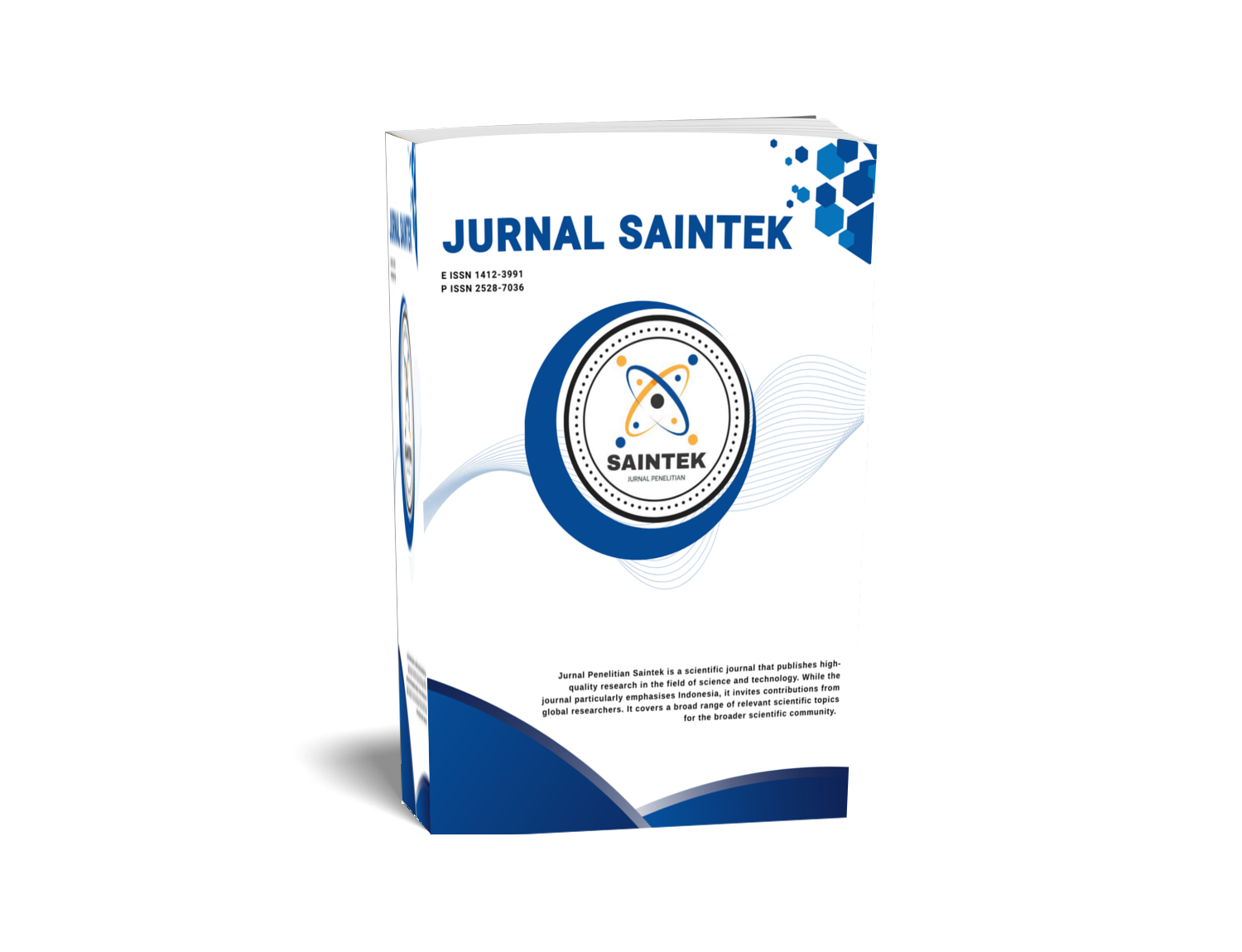Analisis toksisitas dan potensi antikanker ekstrak metanol daun Majapahit (Crescentia cujete) dengan metode Brine Shrimp Lethality Test
DOI:
https://doi.org/10.21831/jps.v1i1.43889Keywords:
tanaman Majapahit, Crescentia cujete, toksisitas, LC50Abstract
Analysis of toxicity and anti-cancer potential of Majapahit (Crescentia cujete) leaf methanol extract using Brine Shrimp Lethality Test method
The Majapahit plant (Crescentia cujete) is one of the plants in Indonesia which is known to have phenolic compounds, saponins, tannins, alkaloids, and terpenoids. Several types of compounds belonging to the phenol group are known to have anticancer activity. The study aimed to determine the toxicity of the methanol extract of the leaves of Majapahit using the Brine Shrimp Lethality Test (BSLT) method. Toxicity test was done using five concentrations of Majapahit leaf methanol extract, there were 500, 400, 300, 200, and 100 ppm. The Majapahit extract was then tested on Artemia salina L. shrimp larvae aged 48 hours. At each concentration, ten larvae were used with three repetitions. Larvae mortality data for each concentration of the extract would be used to carried out probit analysis to determine the LC50 value. Based on the results of the probit analysis of the mortality of shrimp larvae at each extract concentration, it could be seen that the LC50 value of the Majapahit leaf methanol extract is 642.877ppm. So, it means that the extract is toxic and has the potential to be developed as an anticancer because it has an LC50 value of <1000 ppm.
References
Adusei, S. (2020). Bioactive compounds and antioxidant evaluation of methanolic extract of Hibiscus sabdarifa. IPTEK The Journal of Technology and Science, 31(2), 139-147.
Anwar, S., Yulianti, E., Hakim, A., Fasya, A. G., Fauziyah, B., & Muti'ah, R. (2014). Uji toksisitas eksrak akuades (Suhu kamar) dan akuades panas (70ËšC) daun kelor (Moringa oleifera Lank.) terhadap larva udang (Artemia salina Leach). ALCHEMY, 3(1), 84-92.
Astarina, N. W. G., Astuti., K. W., & Warditiani., N. K. (2013). Skrining fitokimia ekstrak metanol rimpang bangle (Zingiber purpureum Roxb.). Jurnal Farmasi Udayana, 2(4), 1-6.
Cannel, R. (2000). Methods in biotechnology. Natural products isolation. Human Press.
Ciulei, J. (1984). Metodology for analysis of vegetables and drugs. UNIDO.
Ejelonu, B. C., Lasisi, A. A., Olaremu, A. G., & Ejelonu, O. C. (2011). The chemical constituents of calabash (Crescentia cujete). African Journal of Biotechnology, 10(84), 19631-19636.
Elansary, H. O., Szopa, A., Kubica, P., Al-Mana, F. A., Mahmoud, E. A., El-Abedin, T. K. A., Mattar, M. A., Ekiert, H. (2019). Phenolic compounds of Catalpa speciosa, Taxus cuspidata, and Magnolia acuminata have antioxidant and anticancer activity. Molecules, 24, 412-426.
Elekofehinti, O. O., Iwaloye, O., Olawale, F., & Ariyo, E. O. (2021). Saponins in cancer treatment: Current progress and future prospects. Pathophysiology, 28, 250-272.
Harborne, J. B. (1987). Metode fitokimia: Penuntun cara modern menganalisis tanaman. ITB.
Huang, M., Lu, J. J., Huang, M. Q., Bao, J. L., Chen, X. P., & Wang, Y. T. (2012). Terpenoids: Natural products for cancer therapy. Expert Opinion on Investigational Drugs, 21(12), 1801-1818.
Manongko, P. S., Sangi, M. S., & Momuat., L. I. (2020). Uji senyawa fitokimia dan aktivitas antioksidan tanaman patah tulang (Euphorbia tirucalli L.). Jurnal Mipa, 9(2), 64-69.
Meyer, B. N., Ferrigni, N. R., Putnam, J. E., Jacobson, L. B., Nichols, D. E., & McLaughlin, J. L. (1982). Brine shrimp: A convenient general bioassay for active plant constituents. Planta Medica, 45, 31-34.
Rorong, J. A., Sudiarso, Prasetya, B., Mandang, J. A., & Suryanto, E. (2012). Pytochemical analysis of water hyacinth (Eichhornia crassipes ) of agricultural waste as biosensitizer for ferri photoreduction. Agrivita, 34(2), 152-160.
Salamah, N., & Ningsih, D. S. (2017). Total alkaloid content in various fractions of Taber-naemonata sphaerocarpa Bl. (Jembirit) leaves. IOP Conf. Ser.: Mater. Sci. Eng., 259, 1-6.
Silva, T. M. S., Nascimento, R. J. B., Batista, M. M., Agra, M. F., & Camara, C. A. (2007). Brine shrimp bioassay of some species of Solanum from Northestern Brazil. Revista Brasileira de Farmacognosia, 17(1), 35-38.
Smith, B. A., & Dollear, F. G. (1947). Oil from calabash seed, Crescentia cujete L. Journal of the American Oil Chemists' Society, 24(2), 52-54.
Sukardiman, A. R., & Pratiwi, N. F. (2004). Uji praskrining aktivitas antikanker ekstrak eter dan ekstrak metanol Marchantia cf. planiloba Steph. dengan metode uji kematian larva udang dan profil densitometri ekstrak aktif. Majalah Farmasi Airlangga, 4(3), 90-100.
Sunarni, Iskamto dan Suhartinah. (2003). Uji toksisitas dan antiinfeksi ekstrak etanol buah Brucea sumatrana Roxb. terhadap larva udang Artemia salina Leach. dan Staphylococcus aereus. Biosmart, 5(4): 65-67.
Youness, R. A., Kamel, R., Elkasabgy, N. A., Shao, P., & Farag, M. A. (2021). Recent advances in tannic acid (Gallotannin) anticancer activities and drug delivery systems for effificacy improvement: A comprehensive review. Molecules, 26, 1486-1501.
Downloads
Published
How to Cite
Issue
Section
Citation Check
License
Who Can Submit?
Any individual may submit an original manuscript for consideration for publication in Jurnal Penelitian Saintek as long as they hold the copyright to the work or are authorized by the copyright owner(s) to submit it. Authors retain initial ownership of the copyrights to their works prior to publication, except in cases where, as a condition of employment, they have agreed to transfer copyright to their employer.
User Rights
Jurnal Penelitian Saintek is an Open Access journal. Users are granted the right to read, download, copy, distribute, print, search, or link to the full texts of articles, provided they comply with the conditions of the Creative Commons Attribution-ShareAlike License 4.0 (CC BY-SA 4.0).
https://creativecommons.org/licenses/by-sa/4.0/
Author Rights
Authors retains copyrights.
Jurnal Penelitian Saintek by http://journal.uny.ac.id/index.php/saintek is licensed under a Creative Commons Attribution-ShareAlike 4.0 International License.









